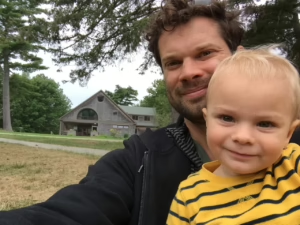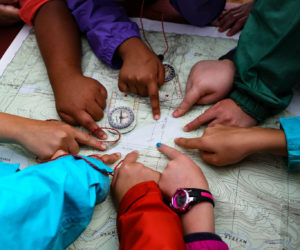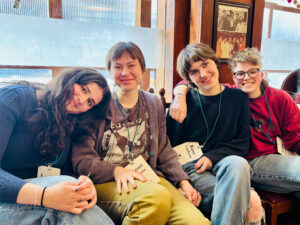Non-judgmental, Non-responsive, Empathetic Listening
In the Nook, a shoebox-shaped room on the west side of the barn with a window on the Quad, Amy Wood teaches “Literature and the Land,” Maine Coast Semester’s signature English course. Over the course of 14 weeks, she leads her students through an eclectic mix of readings, pushing and stretching them to think about self, community, and place, how each exerts its power over the others but is also shaped by them.

“It takes time to plant the seeds,” says Wood. “Some students, in the beginning, have trouble…but I try hard to really point out the similarities among the readings so they can see the continuity.”
Her goal: “to get the students to take the reins. I create a strong curriculum and frame the classes; I want the students to bring the course to life.”
Non-Judgmental, Non-Responsive, Empathetic Listening
The latest addition to the Chewonki songbook and an instant classic is Booth McGowan’s and True Miller’s ballad about a man who discovered in just the nick of time, thanks to a friend, that Amy Wood’s “non-judgmental, non-responsive, empathetic listening” was just what he needed to make his life worthwhile. Enjoy Miller (of Brooklyn, New York) and McGowan (of St. Paul, Minnesota) giving an impromptu but polished performance outside the Wallace.
Wood’s unique vision illuminates this English course. She carefully designs the reading list “to allow many points of entry,” many possibilities for resonance between her students and the writers. Students read the work of poets Tracy K. Smith and Patricia Goedicke. They read Robert McGuire’s graphic novel Here; Transcendentalists Ralph Waldo Emerson and Henry David Thoreau; naturalist and activist Terry Tempest Williams; philosopher and forester Aldo Leopold; Rhonda Frey, a contemporary Penobscot and Passamaquoddy woman; philosophers Daniel Dennett and Paul Ricoeur; and others.
Wood presses her students, as they swim in this rich sea of words and ideas, to think about who they are and what they have to say; what place and community mean to them; how what they are doing each day at Chewonki–from academic work to cabin life to watching ewes give birth to washing dishes–is shaping their own budding sense of identity and voice.
One way she does this is through a bit of playfulness her students call Chat Pack, appropriating the name from a travel game to describe a practice and a discrete sliver of classwork. Two or three times a week, she hands around a small box of cards, each with a question on one side, such as:
“Got a story to share about a time when you were utterly and helplessly lost while driving? Tell your story!”
“Got a story to share about a memorable moment at a funeral? Tell your story!”
“Got a story to share about missing something important because of bad weather? Tell your story!”
Or Wood might roll onto the table a handful of large dice called Story Cubes, each imprinted with simple, graphic images: an egg with a crack in it, an angry-looking stick figure pointing a finger, a glowing sun, etc.
A student can pick a card or one of the dice. If it sparks a memory, the student tells a story, right there on the spot. It must be authentic. It must be their own. Before they begin, Wood asks them to take a moment to think about what constitutes “appropriate self-disclosure, how much of who we are we share, based on the other people in the room,” she says. And she encourages them to be brave. The room and the audience are safe.
The audience is just as active as the storyteller. While the storyteller tries to put experience into spoken words, the listeners practice “non-judgmental, non-responsive, empathetic listening,” says Wood. They are not allowed to comment on the story. When it ends, the class moves to the next story or the day’s readings.
Wood has a deep interest in the study and practice of nonviolent, mindful communication. Drawing on that discipline, Wood teaches her students to read closely, attend to details, listen with heart and ear so they can understand characters and points of view and how language expresses a person’s relationship to the world, whether that world be private or public.
She stumbled across Chat Pack earlier in her teaching career. “I found students really responded to it,” she says. “It was the only strategy that students consistently sought out.” As simple as it seems, Chat Pack helps students strengthen their sense of themselves; polish their public speaking, in a forgiving setting; and develop a personal narrative about their lives.
“If we are asking students to pay attention, we need to give them opportunities to develop and practice that skill, in writing, speaking, and listening,” she explains.
The light-hearted Chat Pack can reveal points of connection between these students and the protagonists in literary works. “The students are developing a deeper sense of their own and other people’s stories,” says Woods. Finding common ground can be revelatory.
Wood has a pragmatic agenda as well. “It’s important to align what we are doing in English class with Maine Coast Semester’s Goals for Graduates,” she says. These goals are: intellectual engagement, community involvement, articulate expression, sense of place, and sense of self. Articulate expression means “writing with clarity, speaking with purpose, and listening with empathy,” says Wood. In her English class, students discover that the other four goals are deeply entwined with expression.
Wood asks her students to use language carefully, recognizing its power to transform, uplift, or destroy. She wants them to comprehend what they read and hear and teaches them to craft their words with an eye toward the goal of all great expression: to communicate the truth in a way that compels another human to understand and not turn away.













